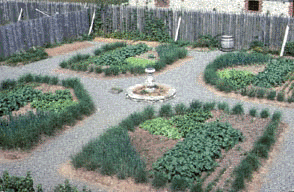
The Gardens

When the French first arrived in Louisbourg, they found the soil to be of below average quality for their gardening. The poor soil combined with the harsh climate inhibited the residents from growing the vegetables and herbs in the quantity or quality of which they were accustomed to in France. Consequently townspeople would often bring soil from other parts of the island and mix it with the original soil in their gardens. The resulting gardens, known as potagers, had an assortment of vegetables and herbs which were used as dyes as well as for cooking and medicinal purposes. Typical vegetables grown were: cabbages, turnip, carrots, beans, and peas. Common herbs were: mint, parsley, sage and thyme.
There were more than 100 gardens in Louisbourg in the 18th century and they were an indication of the social status of the property owner. It was uncommon to see decorative flowers grown in pratical gardens as it was so hard to grow even the basic necessities. The gardens of the richer inhabitants had a symmetrical arrangement of beds, a sundial or urn to give the garden a central focus and they were often arranged in complementing color coordinations. If there were flowers grown they would likely be found in the formal gardens of the well-to-do.
There were specifications followed when planning a garden so that the contents would grow in Louisbourg's climate. The garden was lower than the ground level of the house. Good soil, about 3 feet deep, would have been dark, rich, not too humid and not too dry. The soil was tested for bad odour or taste as fruits and vegetables would pick up these qualities. Testing was done by taking soil from various sections of the garden, placing it into separate containers with water and letting it stand for about eight hours. Finally, the water was filtered through a cloth and tasted for bad qualities.
Gardens usually faced northward, which had its advantages. This was was good for summer and autumn fruits. It also helped preserve vegetables during long periods of heat. Fences were built around the gardens, averaging of 9 feet high, protecting the garden from passers by, theives, animals, and from winds and cold temperatures. Fences also reflected heat onto the plants and helped to maintain the shape of the garden.
 An excellent example of a practical garden was that of Michel de Gannes. It had
soil raised about 3 inches from ground level and was held in place by wooden boards
around the edges. There was no wasted space in this garden. Narrow walkways
provided just enough room to manoeuvre between each section. It contained all the
basic herbs and vegetables.
An excellent example of a practical garden was that of Michel de Gannes. It had
soil raised about 3 inches from ground level and was held in place by wooden boards
around the edges. There was no wasted space in this garden. Narrow walkways
provided just enough room to manoeuvre between each section. It contained all the
basic herbs and vegetables. An excellent example of a formal garden was that of Étienne Verrier. It was considered
to be the most extravagant garden of the entire colony. It contained fewer necessities
than the De Gannes garden, but was very pleasing to the eye. It was composed of four
geometrical formations, containing decorative flowers as well as small amounts of
vegetables and herbs. With a sundial as its central focus and large walkways, this
garden was perfect for entertaining.
An excellent example of a formal garden was that of Étienne Verrier. It was considered
to be the most extravagant garden of the entire colony. It contained fewer necessities
than the De Gannes garden, but was very pleasing to the eye. It was composed of four
geometrical formations, containing decorative flowers as well as small amounts of
vegetables and herbs. With a sundial as its central focus and large walkways, this
garden was perfect for entertaining.


